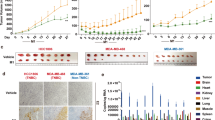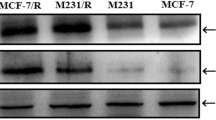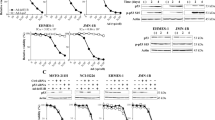Abstract
Chemotherapy, including microtubule (MT)-interacting agents, can enhance the tumor-eradicating activity of replication-competent adenoviruses. The purpose of this study was to obtain more insight into the mechanism underlying this enhancement that may be exploited for the development of improved therapy. Two MT-interacting agents with opposite activity, paclitaxel (PTX) that stabilizes and vincristine (VCR) that destabilizes MTs, were found to synergistically enhance adenoviral oncolysis in non-small-cell lung cancer (NSCLC) cells. To explore the possibility that these drugs affect the viral life cycle by modulating adenoviral gene expression, we used a quantitative reverse transcription-polymerase chain reaction assay and found that PTX, but not VCR, increased the expression of E1A13S, ADP and Penton genes, which correlated with an increase in viral particle assembly and release. Next, the effect of combined treatment on cell-cycle progression was studied. Both drugs suppressed adenovirus-induced S-phase arrest and instead caused G2/M arrest, which was accompanied by an increase in apoptotic cells. Taken together, the enhancement of oncolysis by MT-interacting drugs appears not to require specific MT transport or scaffold functions. Our findings suggest that MT-interacting drug-induced cellular signals that modulate cell-cycle arrest and apoptosis are primarily on the basis of their oncolysis-enhancing activity.
This is a preview of subscription content, access via your institution
Access options
Subscribe to this journal
Receive 12 print issues and online access
$259.00 per year
only $21.58 per issue
Buy this article
- Purchase on Springer Link
- Instant access to full article PDF
Prices may be subject to local taxes which are calculated during checkout






Similar content being viewed by others
References
Kirn D . Replication-selective oncolytic adenoviruses: virotherapy aimed at genetic targets in cancer. Oncogene 2000; 19: 6660–6669.
Alemany R, Balague C, Curiel DT . Replicative adenoviruses for cancer therapy. Nat Biotechnol 2000; 18: 723–727.
McCormick F . Cancer gene therapy: fringe or cutting edge? Nat Rev Cancer 2001; 1: 130–141.
Ganly I, Kirn D, Eckhardt G, Rodriguez GI, Soutar DS, Otto R et al. A phase I study of Onyx-015, an E1B attenuated adenovirus, administered intratumorally to patients with recurrent head and neck cancer. Clin Cancer Res 2000; 6: 798–806.
Kirn D . Oncolytic virotherapy for cancer with the adenovirus dl1520 (Onyx-015): results of phase I and II trials. Expert Opin Biol Ther 2001; 1: 525–538.
Nemunaitis J, Khuri F, Ganly I, Arseneau J, Posner M, Vokes E et al. Phase II trial of intratumoral administration of ONYX-015, a replication selective adenovirus, in patients with refractory head and neck cancer. J Clin Oncol 2001; 19: 289–298.
Khuri FR, Nemunaitis J, Ganly I, Arseneau J, Tannock IF, Romel L et al. Controlled trial of ONYX-015, a replication-selective adenovirus, in combination with cisplatin and 5-FU in patients with recurrent head and neck cancer. Nat Med 2000; 6: 879–885.
Heise C, Sampson-Johannes A, Williams A, McCormick F, Von Hoff DD, Kirn DH . ONYX-015, an E1B gene-attenuated adenovirus, causes tumor-specific cytolysis and antitumoral efficacy that can be augmented by standard chemotherapeutic agents. Nat Med 1997; 3: 639–645.
Yu DC, Chen Y, Dilley J, Li Y, Embry M, Zhang H et al. Antitumor synergy of CV787, a prostate cancer-specific adenovirus, and paclitaxel and docetaxel. Cancer Res 2001; 61: 517–525.
You L, Yang C-T, Jablons DM . ONXY-015 works synergistically with chemotherapy in lung cancer cell lines and primary cultures freshly made from lung cancer patients. Cancer Res 2000; 60: 1009–1013.
Pagliaro LC, Keyhani A, Liu B, Perotte P, Wilson D, Dinney CP . Adenoviral p53 gene transfer in human bladder cancer cell lines: cytotoxicity and synergy with cisplatin. Urol Oncol Semin Orig Invest 2003; 21: 456–462.
Holm PS, Lage H, Bergmann S, Jurchott K, Glockzin G, Bernhausen A et al. Multidrug-resistance cancer cells facilitate E1-independent adenoviral replication: impact for cancer gene therapy. Cancer Res 2004; 64: 322–328.
Barry M, McFadden G . Apoptosis regulators from DNA viruses. Curr Opin Immunol 1998; 10: 422–430.
White E . Regulation of the cell cycle and apoptosis by the oncogenes of adenovirus. Oncogene 2001; 20: 7836–7846.
Shenk T . Adenoviridae: The Viruses and Their Replication. Lippincott-Raven Publisher: Philadelphia, 1996, pp 2111–2137.
Flint SJ . Regulation of Adenovirus mRNA Formation. Academic Press: Princeton, NJ, 1986, pp 169–228.
Abou El Hassan MAI, Braam SR, Kruyt FAE . A real-time RT-PCR assay for the quantitiative determination of adenoviral gene expression in tumor cells. J Virol Methods 2005; 133: 53–61.
Jordan MA, Toso RJ, Thrower D, Wilson L . Mechanism of mitotic block and inhibition of cell proliferation by taxol at low concentrations. Proc Natl Acad Sci USA 1993; 90: 9552–9556.
Wilson L, Jordan MA . Microtubules. John Wiley & Sons, Inc.: New York, 1994, pp 59–83.
Abou El Hassan MA, van der Meulen-Muileman I, Abbas S, Kruyt FA . Conditionally replicating adenoviruses kill tumor cells via a basic apoptotic machinery-independent mechanism that resembles necrosis-like programmed cell death. J Virol 2004; 78: 12243–12251.
Chou TC, Talalay P . Quantitative analysis of dose-effect relationship: the combined effects of multiple drugs on enzyme inhibitors. In: Weber G (ed). Advances in Enzyme Regulation, Vol. 53. Pergamon Press: New York, 1983. pp 27–55.
Sambrook J, Fritsch EF, Maniatis T . Molecular Cloning, A Laboratory Manual. Cold Spring Harbor Laboratory Press: Cold Spring Harbor, NY, 1989.
Ma L, Bluyssen HA, De Raeymaeker M, Laurysens V, van der Beek N, Pavliska H et al. Rapid determination of adenoviral vector titers by quantitative real-time PCR. J Virol Methods 2001; 93: 181–188.
Huisman C, Ferreira CG, Broker LE, Rodriguez JA, Smit EF, Postmus PE et al. Paclitaxel triggers cell death primarily via caspase-independent routes in the non-small cell lung cancer cell line NCI-H460. Clin Cancer Res 2002; 8: 596–606.
Seidman MA, Hogan SM, Wendland RL, Worgall S, Crystal RG, Leopold PL . Variation in adenovirus receptor expression and adenovirus vector-mediated transgene expression at defined stages of the cell cycle. Mol Ther 2001; 4: 13–21.
Suzuki K, Fueyo J, Krasnykh V, Reynolds PN, Curiel DT, Alemany R . A conditionally replicative adenovirus with enhanced infectivity shows improved oncolytic potency. Clin Cancer Res 2001; 7: 120–126.
Heise C, Lemmon M, Kirn D . Efficacy with a replication-selective adenovirus plus cisplatin-based chemotherapy: dependence on sequencing but not p53 functional status or route of administration. Clin Cancer Res 2000; 6: 4908–4914.
Dales S, Chardonnet Y . Early events in the interaction of the adenovirus with Hela cells. IV. Association with microtubules and the nuclear pore complex during vectorial movement of the inoculum. Virology 1973; 56: 465–483.
Sodeik B, Ebersold MW, Helenius A . Microtubule mediated transport of incoming herpes simplex virus 1 capsids to the nucleus. J Cell Biol 1997; 136: 1007–1021.
Suomalainen M, Nakano MY, Keller S, Boucke K, Stidwill RP, Greber UF . Microtubule-dependent plus- and minus-directed motilities are competing processes for nuclear targeting of adenovirus. J Cell Biol 1999; 144: 657–672.
Furukawa Y, Iwase S, Terui Y, Kikuchi J, Sakai T, Nakamura M et al. Transcriptional activation of the cdc2 gene is associated with Fas-induced apoptosis of human hematopoieticcells. J Biol Chem 1996; 271: 28469–28477.
Meikrantz W, Schlegel R . Suppression of apoptosis by dominant negative mutants of cyclin-dependent protein kinases. J Biol Chem 1996; 271: 10205–10209.
Amato SF, Swart JM, Berg M, Wanebo HJ, Mehta SR, Chiles TC . Transient stimulation of the c-Jun-NH2-terminal kinase/activator protein 1 pathway and inhibition of extracellular signal-regulated kinase are early effects in paclitaxel mediated apoptosis in human B lymphoblasts. Cancer Res 1998; 58: 241–247.
Wang TH, Popp DM, Wang HS, Saitoh M, Mural JG, Henley DC et al. Microtubule dysfunction induced by paclitaxel initiates apoptosis through both c-Jun N-terminal kinase(JNK)-dependent and -independent pathways in ovarian cancer cells. J Biol Chem 1999; 274: 8208–8216.
Thierry S, Marechal V, Rosenzwajg M, Sabbah M, Redeuilh G, Nicolas JC et al. Cell cycle arrest in G2 induces human immunodeficiency virus type 1 transcriptional activation through histone acetylation and recruitment of CBP, NF-kappaB, and c-Jun to the long terminal repeat promoter. J Virol 2004; 78: 12198–12206.
Tollefson AE, Scaria A, Hermiston TW, Ryerse JS, Wold LJ, Wold WS . The adenovirus death protein (E3–11.6K) is required at very late stages of infection for efficient cell lysis and release of adenovirus from infected cells. J Virol 1996; 70: 2296–2306.
Liao Y, Zou YY, Xia WY, Hung MC . Enahanced paclitaxel cytotoxicity and prolonged animal survival rate by a non-viral-mediated systemic delivery of E1A gene in orthotopic xenograft human breast cancer. Cancer Gene Ther 2004; 11: 594–602.
Chattopadhyay D, Ghosh MK, Mal A, Harter ML . Inactivation of p21 by E1A leads to the induction of apoptosis in DNA-damaged cells. J Virol 2001; 75: 9844–9856.
Acknowledgements
We thank Guus van der Sluis for his contribution and Dr HM Pinedo and Dr G Giaccone for their support.
Author information
Authors and Affiliations
Corresponding author
Rights and permissions
About this article
Cite this article
Hassan, M., Braam, S. & Kruyt, F. Paclitaxel and vincristine potentiate adenoviral oncolysis that is associated with cell cycle and apoptosis modulation, whereas they differentially affect the viral life cycle in non-small-cell lung cancer cells. Cancer Gene Ther 13, 1105–1114 (2006). https://doi.org/10.1038/sj.cgt.7700984
Received:
Revised:
Accepted:
Published:
Issue Date:
DOI: https://doi.org/10.1038/sj.cgt.7700984
Keywords
This article is cited by
-
Concurrent chemotherapy inhibits herpes simplex virus-1 replication and oncolysis
Cancer Gene Therapy (2013)
-
A Tumor-stroma Targeted Oncolytic Adenovirus Replicated in Human Ovary Cancer Samples and Inhibited Growth of Disseminated Solid Tumors in Mice
Molecular Therapy (2012)
-
Synergistic anti-tumor effects between oncolytic vaccinia virus and paclitaxel are mediated by the IFN response and HMGB1
Gene Therapy (2011)
-
Low-dose paclitaxel synergizes with oncolytic adenoviruses via mitotic slippage and apoptosis in ovarian cancer
Oncogene (2010)
-
The Effect of Cell Cycle Synchronization on Tumor Sensitivity to Reovirus Oncolysis
Molecular Therapy (2010)



